Page content
Governor's Palace
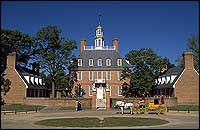
Home to seven royal governors, Patrick Henry and Thomas Jefferson
A professor from the College of William and Mary sketched a Williamsburg vista in a book published in 1724, when the city was just 25 years old.
"From the Church," he said, "runs a Street northward called Palace Street; at the other end of which stands the Palace or Governor's House, a magnificent Structure built at the publick Expense, finished and beautified with Gates, Fine Gardens, Offices, Walks, a fine Canal, Orchards, &c. . . . This likewise has the ornamental Addition of a good Cupola or Lanthorn, illuminated with most of the Town, upon Birth-Nights, and other Nights of occasional Rejoicings."
The Governor’s Palace was new then. It had been finished in 1722 after 16 years of fitful building and mounting expense.
Governor Nott persuaded Virginia General Assembly to authorize construction
Governor Edward Nott persuaded the General Assembly to authorize its construction with an act passed October 23, 1705, and building began the following summer. The act directed contractor Henry Cary to erect a two-story brick house that measured inside 54 feet long and 48 feet wide, had sash windows, a cellar, one vault, a kitchen, and a stable. It was to be erected on 63 acres on the city's north side, purchased from Henry Tyler, and whatever adjacent town lots might be needed. Cary laid foundations 61 feet long and 54 ½ feet wide in the summer of 1706. Appropriation of the £3,000 needed to get started was withheld until June 22 of the following year.
Work proceeded, but soon the money was gone. Cary asked for and got another £400 on April 28, 1708. But the house stood unfinished in 1710, when he was discharged for accounting irregularities and replaced by John Tyler.
Governor Spotswood pushed for completion of home for Virginia chief executive
Alexander Spotswood arrived that year to replace the deceased Nott. The new chief executive pushed for the Palace's completion, and on December 9 the legislature provided another £1,560, with £635 more to be spent on outbuildings, gardens, ornaments, furniture, and a four-foot wall around it all.
The entrance hall seems to have been completed in October of 1711. Spotswood had decorated it with a display of bayonet-tipped muskets when William Byrd came to visit that month. Another act to finish and beautify the residence passed in 1713, but it was three more years before Spotswood took up residence, and the work was still incomplete in 1718.
The House of Burgesses was tiring of the continuing expense. It complained on November 21 that Spotswood was "lavishing away all the country's money" on the project. Spotswood promised to pay for the canal and the terraced gardens if the burgesses would not.
First called "Palace" in 1714
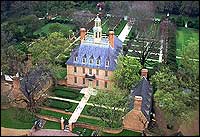 The word "Palace" was first used for the governor's house about 1714. Whether the term was used as irony in reference to its expense, or simply to designate an official residence is debatable. When all was at last done, however, the building measured up to the name compared to other colonial structures, but not to European palaces. There stood a five-bay Georgian home laid up in Flemish bond with glazed headers and rubbed brick window jambs and lintels. It had three floors of about 3,380 square feet each, a cellar with 11 wine bins, a row of dormers in the roof, and an iron balcony at the central upper window. Just inside the gate – guarded by a stone unicorn on one side and a stone lion on the other – stood two one-and-one-half story brick advance buildings with gabled roofs. They ran perpendicular to the main structure. The structure was a “tastemaker” in Virginia. Virginia planters building their own great houses sought to both emulate and exceed it. For the last two royal governors especially, however, the Palace was a far humbler accommodation than their great houses back home.
The word "Palace" was first used for the governor's house about 1714. Whether the term was used as irony in reference to its expense, or simply to designate an official residence is debatable. When all was at last done, however, the building measured up to the name compared to other colonial structures, but not to European palaces. There stood a five-bay Georgian home laid up in Flemish bond with glazed headers and rubbed brick window jambs and lintels. It had three floors of about 3,380 square feet each, a cellar with 11 wine bins, a row of dormers in the roof, and an iron balcony at the central upper window. Just inside the gate – guarded by a stone unicorn on one side and a stone lion on the other – stood two one-and-one-half story brick advance buildings with gabled roofs. They ran perpendicular to the main structure. The structure was a “tastemaker” in Virginia. Virginia planters building their own great houses sought to both emulate and exceed it. For the last two royal governors especially, however, the Palace was a far humbler accommodation than their great houses back home.
Beyond the house was a formal garden in which guests could stand on the mound of earth that covered the icehouse to look into a large, naturalistic park that stretched away to the north. The stable, carriage house, kitchen, scullery, laundry, and an octagonal bathhouse were arranged in service yards beside the advance buildings.
A Busy Complex
Three surviving inventories of personal property attest to the elaborate furnishings of a household that required approximately 25 servants and slaves to tend. Depending upon their duties, some of these servants and slaves lived and worked in the outbuildings, while some lived and worked in the main house. There were stewards, personal servants, butlers, footmen, cooks, laundresses, gardeners, maids, grooms, and laborers. Some governors brought white servants with them and supplemented this core work force with servants and slaves purchased or hired in Virginia. The governor maintained his office in the complex, and his clerk or clerks worked here as well.
In addition, tradesmen and laborers were hired from town as needed. The newspapers were delivered. Beggars came through the gates looking for assistance. The slaves of colonial officials arrived bearing gifts of local foodstuffs or wildlife and were tipped for their services. Physicians from town attended the governor’s family, servants, and slaves.
Part of the butler’s duties consisted of sorting out these many visitors and determining where they should wait and whom they should see. In the words of one modern writer, the Palace visitor traveled a "carefully orchestrated procession of spaces moving toward and culminating in the presence" of the king's immediate representative in Virginia. Down Palace green, through the ornamental iron gates, across the forecourt, up the stone steps, into the hall with its display of muskets and the royal coat of arms, up the stairs, and into the governor's upper middle room, the fortunate and important visitor arrived at the chamber of power. Those of lesser status remained downstairs or outside.
Governors who lived in the original palace included:
- Alexander Spotswood
- Hugh Drysdale
- William Gooch
- Robert Dinwiddie
- Francis Fauquier
- Norborne Berkeley, Baron de Botetourt
- John Murray, fourth Earl of Dunmore
- Patrick Henry
- Thomas Jefferson
Each governor made improvements and repairs, but after Gooch left in 1749, the colony's Council concluded the building was in "ruinous condition" and ordered renovations. The bill for these renovations came to just over £1,259. When Dinwiddie arrived in 1751, the work was still under way and the colony had to buy a house next door – today's Robert Carter House – from Dr. Kenneth McKenzie so the governor would have someplace to stay.
After Dinwiddie moved into the Palace in 1752, the rear wing with its ballroom and supper room was raised. The contractor was Richard Taliaferro, builder of the George Wythe House. With this addition, Virginians were following an English trend. With the new emphasis on sociability, large and fashionable rooms were added to homes and public houses to facilitate dancing and other entertainments. The dining room at the Peyton Randolph House and the Apollo at the Raleigh were built at approximately the same time.
Elegant and festive balls held at the Palace
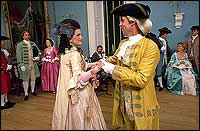 The Palace hosted the colony’s fashionable society and finest entertainments. The October 31, 1771, Virginia Gazette reported:
The Palace hosted the colony’s fashionable society and finest entertainments. The October 31, 1771, Virginia Gazette reported:
"Last Friday night being the anniversary of our Most gracious Sovereign's Accession to the Throne, his Excellency the Governor gave a Ball and an elegant Entertainment at the Palace, to a numerous and splendid Company of Ladies and Gentlemen."
The arrival of a Cherokee chief to sign a treaty, the assembly of enough people at Publick Times to have "a rout" (as balls were sometimes called), and certainly the king's birthday (or accession) and the queen’s birthday were occasions for Palace galas. Governors often hosted a ball at some time during the twelve days of Christmas. On the highest occasions, lights might be put in the windows of the little tower or lantern (or "lanthorn" as it was called) that crowned the flat, balustraded roof.
Governors hosted gala events for large gatherings
Governor Alexander Spotswood spoke of playing host to 200 people one night. Charged with winning over the rebellious Virginia planters, Governor Norborne Berkeley, baron de Botetourt, received 52 dinner guests one day, and expected as many more the next. The governor's table was set with the finest linen, silver, and ceramics; his food was delicious, and his wines were excellent. Yet as tempting as it might be, the Palace's hospitality sometimes was declined. After Governor Francis Fauquier dissolved the House of Burgesses during the Stamp Act crisis in 1765, fewer than a dozen people appeared for his king's birth-night celebration.
When the city recoiled from the removal of gunpowder from the Magazine in 1775, Dunmore summoned 40 sailors to the Palace to protect him from angry citizens. On May 15, 1775, he said he had turned it into a garrison. On June 8, Dunmore fled under cover of darkness, never to return. The Palace muskets and swords were pulled from its decorative displays by a delegation of local men and carried to the Powder Magazine for use in defending the colony. Dunmore's personal slaves and private furniture were later sold at public auction.
General Charles Lee of the Continental army made the Palace his headquarters until it became a hospital. Then Virginia's government ordered the structure renovated for Governor Patrick Henry. Henry was allowed to add new furnishings until the value of the Palace appointments and repairs reached £1,000.
Government moved to Richmond, ending governor's residence
Thomas Jefferson succeeded Henry in office and residence. In 1779 he drew a floor plan of the Palace, perhaps with a view to remodeling. The government, however, moved the next year to Richmond, and nothing came of the plans.
The Palace served again as a hospital in the fall of 1781, this time for American soldiers wounded in the Battle of Yorktown. Some 156 of them, and two women, are buried in the garden.
Building destroyed by fire in December 1781
On December 22, 1781, a fire that may have begun in the basement destroyed the building. A Charleston newspaper account said:
"Last Saturday night about eleven o'clock the palace in the City of Williamsburg, which is supposed to have been set on fire by some malicious person, was in three hours burnt to the ground. This elegant building has been for sometime past a continental hospital, and upwards of one hundred sick and wounded soldiers were in it when the fire was discovered, but by the timely exertions of a few people, only one perished in the flames."
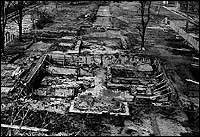
The government sold the bricks – which were being stolen – and the advance buildings in 1782. When Dunmore's grandson Sir Charles Augustus Murray visited in 1835, he wrote, "The centre of the palace where the governor resided has long since fallen down, and even the traces of its ruins are no more to be seen." In 1862, Union soldiers pulled down the advance buildings so officers at Fort Magruder east of town might have bricks to build chimneys for their huts.
In ruins from a fire, the site passed to the College of William & Mary
The site passed to the College of William and Mary after the war. Two school buildings stood on the Palace grounds, just in front of the buried foundations, when The Colonial Williamsburg Foundation purchased the property in 1928. Archaeological investigation began at 8 a.m., June 30, 1930. Nearly two years of work uncovered the original footings, the cellars, debris from the fire, and a section of original wall.
The artifacts, Jefferson's drawings, General Assembly records, and a copperplate engraving discovered in England's Bodleian Library in 1929 were employed in faithful reconstruction of the original buildings. They opened as an exhibition on April 23, 1934.
The reconstructed Palace is refurnished
From the 1930s until 1980 the reconstructed Palace was elegantly furnished with fine British and American antiques arranged in what is now recognized as the Colonial Revival style. Subsequent research confirmed that the rooms, though handsome, bore little resemble to their 18th-century counterparts. In 1981, the detailed 1770 estate inventory of Governor Botetourt's furnishings enabled curators to replicate the interior decor of the 18th-century with precision.
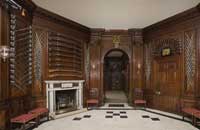
Further revisions were made to the furnishings in 2006, when Botetourt’s bachelor household gave way to a new arrangement reflecting the presence of Governor Dunmore, who resided at the Palace with his wife and six of their seven children. The new installation included Lady Dunmore’s large dressing room, sleeping space for the Dunmore children, and a highly accurate replication of the arms arrangement in the front hall.
